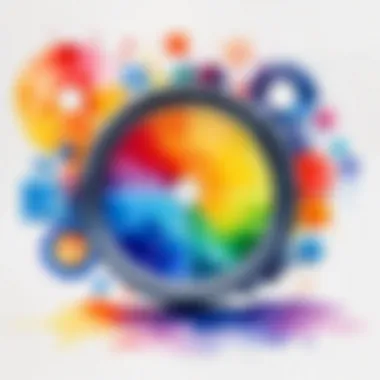Color Supply Influence: Strategic Insights for Modern Businesses


Technological Research Overview
In the fast-paced landscape of modern businesses, color supply plays a pivotal role in shaping consumer behavior and brand identity. Recent technological innovations have revolutionized the way businesses utilize color to enhance their operations and marketing strategies. From advancements in color matching technologies to the rise of AI-powered color analysis tools, businesses now have access to sophisticated solutions that can fine-tune their use of color in captivating ways, elevating their market presence and impact.
Data Analytics in Business
Understanding the importance of data analytics in decoding the intricacies of color supply is crucial for modern businesses. Leveraging cutting-edge tools for data analysis allows businesses to make informed decisions in strategic color selection. Case studies showcasing the power of data-driven color choices underscore how analytical insights can drive successful marketing campaigns and brand communications, leading to increased consumer engagement and loyalty.
Cybersecurity Insights
As businesses delve deeper into the digital realm to optimize their color supply strategies, cybersecurity becomes a pressing concern. Conducting a thorough threat landscape analysis is essential in safeguarding valuable color-related data from malicious cyber threats. Implementing best practices in cybersecurity and ensuring regulatory compliance not only protect businesses from potential breaches but also instill trust in consumers regarding the secure handling of their color preferences and information.
Artificial Intelligence Applications
The integration of artificial intelligence in businesses has opened up new frontiers for enhancing color supply mechanisms. AI-driven business automation tools streamline color production processes, ensuring efficiency and consistency in color output. Delving into the ethical considerations of AI-generated color choices adds a layer of transparency and responsibility, ultimately contributing to meaningful and impactful color strategies that resonate with target audiences.
Industry-Specific Research
Across various industries, tech research continues to drive innovation in color supply methodologies. In the finance sector, tech advancements are reshaping how financial institutions leverage color in branding and customer interactions to establish trust and credibility. The healthcare industry embraces technological solutions to enhance patient experiences through color-based design principles, while the retail sector leverages tech-driven solutions to create immersive color experiences that drive foot traffic and boost sales.
Introduction to Color Supply
Understanding Color Psychology: Impact of Colors on Emotions
The enchanting realm of color psychology holds sway over human emotions, guiding individuals through a kaleidoscope of feelings and perceptions. The impact of colors on emotions is not merely superficial but delves deep into the subconscious, evoking varied responses depending on the hues employed. For businesses, understanding this intricate interplay is instrumental in crafting marketing strategies that resonate with target audiences. By leveraging the emotional triggers associated with different colors, companies can subtly influence consumer decisions, injecting vitality and meaning into their brand narratives. The utilization of warm tones to evoke comfort or cool shades to instill a sense of professionalism showcases the versatility of colors in eliciting specific emotional responses.
Understanding Color Psychology: Association of Colors with Meanings
The association of colors with meanings transcends mere aesthetics, offering a powerful tool for businesses to craft compelling brand narratives. Every hue carries symbolic significance, embedded in cultural contexts and individual perceptions, making color selection a strategic endeavor. By aligning brand values with color meanings, companies can establish a coherent identity that resonates with their target demographic. Whether instilling trust through the regal connotations of blue or igniting passion with the vibrancy of red, the choice of colors communicates subtle yet potent messages to consumers. Leveraging the rich tapestry of color meanings empowers businesses to forge enduring connections with their audiences, fostering brand loyalty and recognition.


Understanding Color Psychology: Cultural Significance of Colors
The cultural significance of colors adds another layer of complexity to the multifaceted world of color psychology. Colors carry diverse meanings across different cultures, highlighting the importance of cultural context in color perception. What may symbolize purity in one society could signify mourning in another, underscoring the need for cultural sensitivity in color usage. Businesses navigating global markets must tread carefully, ensuring that their color choices resonate positively across diverse cultural landscapes. By embracing the cultural nuances of colors, companies can steer clear of unintended implications and foster inclusivity in their marketing endeavors.
Utilizing Color Supply for Marketing Strategies
Color supply plays a crucial role in shaping marketing strategies for businesses in the modern landscape. The selection of colors in marketing materials can significantly impact how a brand is perceived by its target audience, influencing consumer behavior and brand recognition. Understanding the psychology of colors is key to strategically using them in marketing campaigns. Different colors evoke distinct emotions and associations, making it essential for businesses to choose their color schemes wisely to convey the right message.
Color Selection in Marketing Materials
Choosing Colors Based on Target Audience
When it comes to choosing colors based on the target audience, businesses must consider demographic factors such as age, gender, cultural background, and psychographics. Colors have the power to elicit specific responses from different audience segments, making it vital to align the color palette with the preferences and expectations of the target market. By selecting colors that resonate with the audience, businesses can establish a strong visual identity and foster a more profound connection with their customers.
Impact of Color Contrast on Visibility
The contrast between colors in marketing materials can influence their visibility and readability. High color contrast can make important information stand out and improve overall legibility. On the other hand, poor color contrast may result in lower engagement and comprehension among the audience. It is crucial for businesses to strike a balance between aesthetic appeal and functional visibility to ensure that their marketing materials effectively convey the intended message to the target audience.
Color Harmony in Design
Achieving color harmony in design involves creating visually pleasing combinations that enhance the overall appeal of marketing materials. Harmonious color schemes can help business deliver a coherent brand message and create a memorable visual experience for consumers. Consistency in color usage across different platforms and channels is essential to maintaining brand identity and building brand recognition. By incorporating color harmony in design, businesses can strengthen their brand presence and leave a lasting impression on their audience.
Influencing Consumer Behavior through Color
Creating Call-to-Action with Color
Colors can be powerful tools for creating effective call-to-action elements in marketing campaigns. By strategically using bold and attention-grabbing colors for buttons or links, businesses can guide consumer behavior and encourage specific actions such as making a purchase or signing up for a service. The use of color psychology in call-to-action design can significantly impact click-through rates and conversion rates, ultimately leading to improved campaign performance.
Color's Role in Purchase Decisions


The role of color in purchase decisions is multifaceted, influencing consumers' perceptions of product quality, trustworthiness, and value. Different colors can evoke varying emotions and trigger specific responses, shaping how consumers evaluate and interact with a product or service. Businesses can leverage color strategically to appeal to their target market and differentiate their offerings in a competitive marketplace. Understanding the psychological properties of colors is crucial for optimizing the impact of color on consumer behavior and driving purchase decisions.
Color Perception in Advertising
Color perception in advertising plays a pivotal role in capturing audience attention and conveying brand messages effectively. The use of colors in advertising can evoke emotions, create brand associations, and influence consumer preferences. Businesses need to consider how different colors are perceived in various cultural contexts and ensure that their color choices align with the intended brand image. By leveraging color psychology in advertising, businesses can create impactful campaigns that resonate with their target audience and drive engagement and conversion.
Implementing Effective Color Supply Strategies
In this article, the section on Implementing Effective Color Supply Strategies delves into the essential elements and benefits of strategically utilizing colors in modern businesses. Understanding the intricate details of color application can have a profound impact on brand identity and consumer perception. By implementing defined color strategies, businesses can create a cohesive visual language that resonates with their target audience. Considerations about Implementing Effective Color Supply Strategies include color psychology, brand positioning, and consumer engagement. By adopting a strategic approach to color selection and consistency, businesses can enhance their brand recognition and market appeal.
Color Palettes and Combinations
Understanding Color Wheel Principles
The discussion surrounding Understanding Color Wheel Principles emphasizes the significance of color theory in designing cohesive and visually appealing branding materials. By incorporating fundamental color wheel principles, businesses can achieve harmony and balance in their color palettes. This approach allows for the systematic selection of colors that complement each other, creating a cohesive brand aesthetic. Understanding Color Wheel Principles is a popular choice in this article due to its universal applicability across various design contexts. Its unique feature lies in providing a structured framework for choosing colors that evoke specific emotions and convey brand messaging effectively.
Exploring Monochromatic vs. Complementary Schemes
Exploring Monochromatic vs. Complementary Schemes highlights the contrasting approaches to color combinations in design. While monochromatic schemes focus on variations of a single color, complementary schemes involve pairing colors opposite each other on the color wheel. Each scheme offers distinct advantages, with monochromatic schemes promoting simplicity and elegance, and complementary schemes creating dynamic visual interest. Understanding the unique feature of each scheme is crucial in selecting the most suitable option based on branding objectives and target audience preferences.
Trends in Color Usage
The exploration of Trends in Color Usage underscores the dynamic nature of color preferences in design and marketing. Staying informed about current color trends enables businesses to stay relevant and appealing to their target demographic. By incorporating trending colors strategically, organizations can leverage the power of visual aesthetics to captivate their audience. However, it is essential to balance trendiness with brand consistency to ensure a timeless brand identity. Understanding the advantages and disadvantages of following color trends is vital in aligning color choices with brand values and market positioning.
Testing and Optimizing Color Choices
AB Testing for Color Variations
AB Testing for Color Variations is a crucial aspect of refining color choices based on empirical data and audience preferences. By conducting AB tests with different color variations, businesses can gather insights into which colors resonate best with their target market. This data-driven approach minimizes guesswork and allows for informed decisions when selecting colors for branding and marketing materials. The unique feature of AB Testing lies in its ability to quantify the impact of color on consumer behavior and engagement, providing actionable data for optimizing color choices.


Analyzing Heat Maps for Color Preference
Analyzing Heat Maps for Color Preference involves studying visual heat maps to identify areas of focus and user interactions within design layouts. By analyzing how users engage with different color elements, businesses can determine which colors attract attention and drive desired actions. Heat map analysis offers valuable insights into color preferences and optimization opportunities for enhancing user experience. However, interpreting heat map data requires a nuanced understanding of user behavior and design psychology to derive meaningful conclusions for color optimization.
Iterative Approach to Color Optimization
The Iterative Approach to Color Optimization emphasizes the iterative nature of refining color choices based on continuous feedback and performance metrics. By adopting an iterative approach, businesses can incrementally improve color strategies based on real-time data and user feedback. This data-driven optimization process allows for fine-tuning color elements to maximize visual impact and audience engagement. The key characteristic of an iterative approach is its flexibility and openness to adaptation, ensuring that color choices remain dynamic and responsive to changing market dynamics and consumer preferences.
Evaluating Success Metrics of Color Supply
To elucidate the critical significance of evaluating success metrics of color supply in the domain of modern businesses, it becomes imperative to comprehend the overarching impact that colors bear on brand recognition and consumer engagement. By intricately dissecting and analyzing the efficacy of chosen color schemes, businesses can ascertain the effectiveness of their branding strategies and marketing tactics. Through a meticulous assessment of color preferences, associations, and psychological responses, companies can fine-tune their color supply to resonate with target audiences and enhance brand perception. Successful evaluation of color metrics can lead to heightened brand visibility, customer loyalty, and competitive edge in the market landscape.
Measuring Brand Recognition and Recall
Unraveling the realm of brand recognition and recall through comprehensive surveys and detailed focus groups provides invaluable insights into consumer sentiments and perceptions regarding color association. By harnessing the power of surveys and focus groups tailored towards analyzing color nuances, businesses can gauge the effectiveness of their brand identity elements and marketing communications. Surveys and focus groups serve as a direct conduit to deciphering the resonance of color choices with the target demographic, highlighting strengths and vulnerabilities within the brand's visual language. This methodical approach facilitates a deeper understanding of consumer behavior and aids in crafting targeted branding strategies that foster lasting brand recall. Despite their considerable advantages, surveys and focus groups necessitate careful interpretation and consideration of response biases to extract accurate and actionable data for enhancing color strategies.
Tracking Click-Through Rates with Color Experiments
Delving into the realm of tracking click-through rates through color experiments unveils a realm of empirical data essential for optimizing digital marketing initiatives and online engagement strategies. By meticulously monitoring and analyzing user interactions with varied color schemes across digital platforms, businesses can gauge the impact of color on click-through rates and user engagement metrics. Tracking such data allows for iterative refinement of color choices to maximize conversions and enhance overall brand performance in digital spaces. While tracking click-through rates through color experiments offers valuable insights into user behavior and preferences, it necessitates a dynamic approach to adapt and evolve color strategies in alignment with changing market dynamics and user expectations.
Quantifying Color Impact on Conversions
As businesses navigate the intricate landscape of quantifying color impact on conversions, a profound understanding of color psychology and consumer behavior patterns emerges as a critical asset for informed decision-making. By quantifying the direct correlation between color choices and conversion rates, companies can discern the tangible impact of color on consumer actions and purchasing behaviors. This data-driven approach empowers businesses to refine their color strategies, emphasize high-converting color elements, and mitigate potential barriers to conversions effectively. However, quantifying color impact on conversions requires rigorous data analysis, statistical methodologies, and continuous optimization to ensure sustained success in driving desired consumer actions and achieving measurable business outcomes.
Adapting to Changing Market Dynamics
In the ever-evolving landscape of market dynamics, the adaptive flexibility of color strategies emerges as a cornerstone for maintaining brand relevance and resonance amidst competitive shifts and consumer trends. By fostering a culture of adaptability within color strategy frameworks, businesses can swiftly respond to emerging market trends, competitor actions, and consumer preferences to retain a competitive edge. The ability to pivot color strategies in response to market dynamics enables brands to stay agile, resonate with evolving consumer tastes, and capitalize on emerging opportunities effectively. While embracing flexibility in color strategy offers inherent advantages in responsiveness and market adaptation, it necessitates a delicate balance between consistency in brand identity and proactive exploration of new color avenues to remain attuned to changing consumer demands and industry trends.
Responsive Color Updates
Embarking on the journey of responsive color updates underscores the proactive approach towards maintaining brand relevance and consumer appeal in a dynamic business environment. By swiftly and effectively implementing color updates in response to market feedback, consumer preferences, and design trends, brands can demonstrate agility and relevance in their visual communications. Responsive color updates serve as a strategic tool for aligning brand aesthetics with contemporary design standards, consumer expectations, and market dynamics, ensuring sustained brand resonance and engagement. While responsive color updates offer a competitive advantage in adapting to evolving visual trends and consumer expectations, businesses must remain vigilant of overhauling brand identity elements frequently, balancing innovation with brand consistency to forge enduring connections with audiences.
Staying Ahead of Color Trends
Anticipating and proactively staying ahead of color trends signifies a proactive stance towards innovation and differentiation in the realm of color supply and branding strategies. By vigilantly monitoring market trends, design influences, and consumer preferences, businesses can preemptively embrace emerging color trends and inject fresh perspectives into their visual identity. Staying ahead of color trends fosters a cutting-edge brand persona, resonates with avant-garde consumer segments, and positions brands as pioneers in visual communications. Despite the advantages of staying ahead of color trends in signaling brand innovation and adaptability, businesses must exercise prudence in balancing trend-driven elements with timeless brand attributes to preserve brand authenticity and relevance over time.







